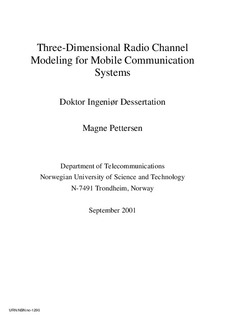| dc.contributor.author | Pettersen, Magne | nb_NO |
| dc.date.accessioned | 2014-12-19T13:29:54Z | |
| dc.date.available | 2014-12-19T13:29:54Z | |
| dc.date.created | 2001-12-12 | nb_NO |
| dc.date.issued | 2001 | nb_NO |
| dc.identifier | 126173 | nb_NO |
| dc.identifier.isbn | 82-471-5355-6 | nb_NO |
| dc.identifier.uri | http://hdl.handle.net/11250/249842 | |
| dc.description.abstract | The work described in this report is within the area of three-dimensional (3D) radio channel modeling for mobile communications. The focus was towards rural areas, because radio coverage of rural areas is more costly when using higher frequencies, comparing UMTS to GSM. In addition seasonal and environmental variations are strongest here. The model used was a 3D radar model, comprised of a 2D vertical Tx-Rx-plane component and a 3D components to include off-axis scattering. The latter components are estimated using bistatic radar techniques. The model is able to provide an accurate estimation of the path loss (signal level), and is also able to estimate time dispersion and angular dispersion, taking into account off-axis contributions. Radio frequencies around 2 GHz were selected, as these are the most important frequency bands for 3. generation mobile systems, even though the envisaged approach supports radio planning for GSM 900 and WLAN systems.
A novel approach to the modeling of scattering from random rough surfaces for 3D channel modeling was developed. This amplitude/phase model is simple and accurate compared to conventional models. It makes no inherent assumption about the degree of roughness, making it suited to model all surfaces. The model outperforms the conventional models Plane surface, SPM, Kirchoff and Oren with respect to accuracy by 1.5 to 10 dB depending on the degree of roughness.
An experimental methodology to characterise random rough surfaces was developed. The work characterised natural surfaces such as asphalt, grass, agriculture, and forest, each of them having a different degree of roughness. Variations due to weather and seasonal changes were taken into account. Typical surface height variations estimated were 10 mm for asphalt, 25 mm for grass, 100 mm for ploughed field and 500 mm for forest. Snow reduced the apparent roughness of ploughed field by 50 %, water on grass increased the reflection coefficient by 50 %.
An analysis of the implications of the results on 3D channel modeling was performed using a demonstration model. The analysis included a comparison between 2D and 3D model prediction for different area types and land use classes. Also the prediction sensitivity to seasonal and weather variations and model parameter variations were inspected. A 3D model is necessary when the 2D component is attenuated more than typically 15 dB relative to free space, depending on area and land usage. In the network planning example Lillehammer (N) this attenuation of at least 15 dB existed in 40 % of all locations. Weather and seasonal variations may change the mean predicted value by up to 4-5 dB. | nb_NO |
| dc.language | eng | nb_NO |
| dc.publisher | Fakultet for informasjonsteknologi, matematikk og elektroteknikk | nb_NO |
| dc.relation.ispartofseries | Dr. ingeniøravhandling, 0809-103X; 2001:89 | nb_NO |
| dc.subject | | en_GB |
| dc.subject | Telekommunikation | en_GB |
| dc.subject | TECHNOLOGY: Information technology: Telecommunication | en_GB |
| dc.title | Three-Dimensional Radio Channel Modeling for Mobile Communications Systems | nb_NO |
| dc.type | Doctoral thesis | nb_NO |
| dc.source.pagenumber | 183 | nb_NO |
| dc.contributor.department | Norges teknisk-naturvitenskapelige universitet, Fakultet for informasjonsteknologi, matematikk og elektroteknikk | nb_NO |
| dc.description.degree | dr.ing. | nb_NO |
| dc.description.degree | dr.ing. | en_GB |
